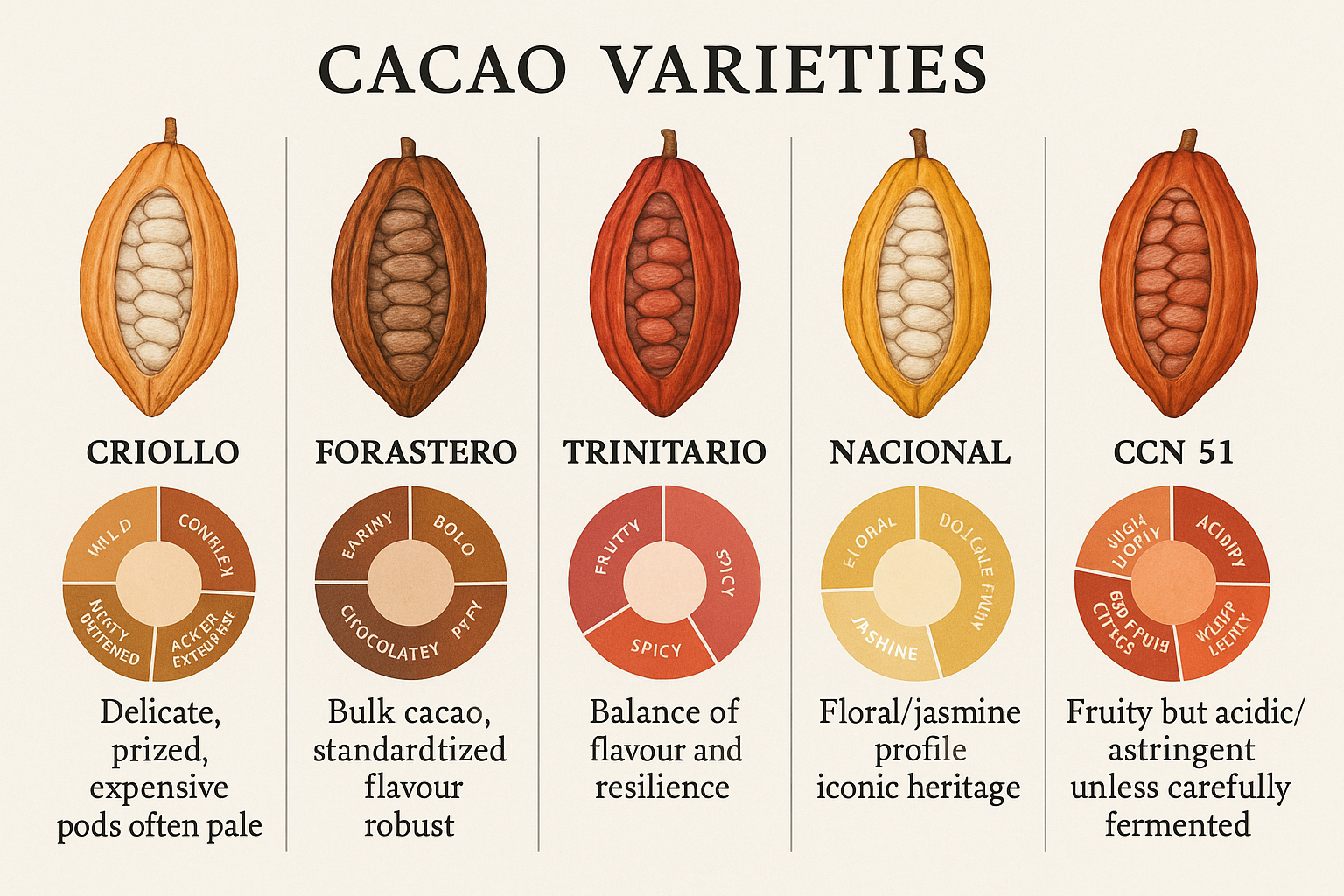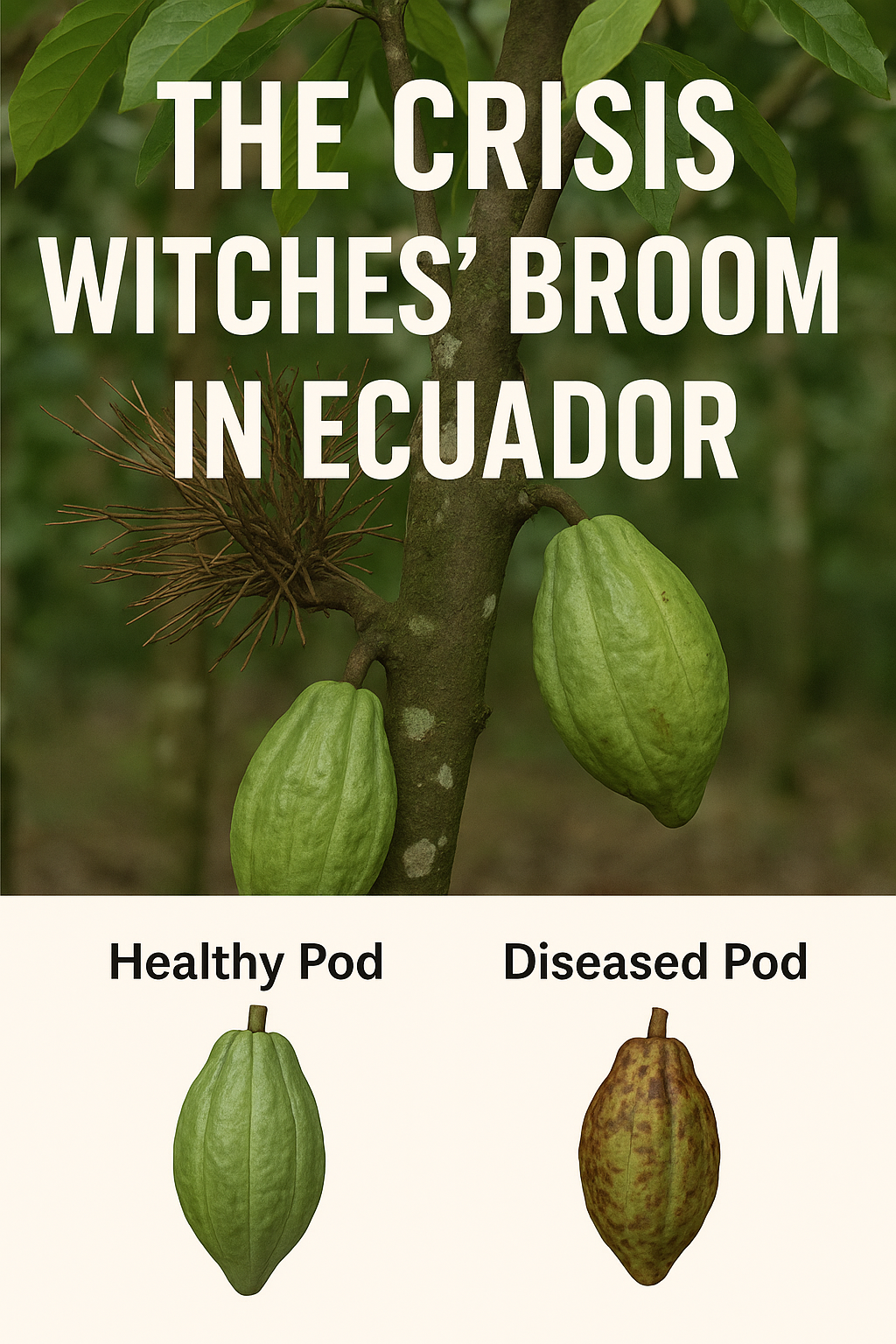
Key Takeaways
CCN 51 was developed by Homero Castro to fight witches’ broom and stabilise yields. It remains highly disease-resistant and productive in challenging environments.
Early flavour reviews were poor, yet skilled fermentation can reveal red-berry, tropical fruit, and soft caramel notes.
Heritage cacao in agroforestry can produce for 200+ years; intensive blocks are often renewed at 20–25 years.
The Crisis: Witches’ Broom in Ecuador
In the 1960s and ’70s, Ecuador’s cacao heritage came under siege. Witches’ broom, a devastating fungal disease, warped pods and wiped out yields, pushing once-thriving farms towards financial ruin. The fear was real: Ecuador’s fine-flavour cacao — a cultural and economic cornerstone — seemed at risk of fading.
The Response: Homero Castro’s Breeding Programme
Enter Homero Castro, an Ecuadorian botanist with a clear goal: resistance, resilience, and reliable yield without losing saleable flavour.
Over 12 years of crossing and selection, he created Colección Castro Naranjal 51 — CCN 51 (the “51” marks the number of crosses). By 1977, the variety was field-ready: highly resistant to witches’ broom, hardy where others failed, and delivering significantly higher yields.
Longevity vs Throughput: Two Ways to Grow Cacao
Heritage cacao — such as Nacional in Ecuador, Criollo in Venezuela, and ancient forest cacao in Bolivia — typically grows within mixed agroforestry. With shade, seasonal pruning, and forest-floor organic matter, these trees can produce for 200 years or more.
The emphasis is steady, high-quality production across generations.
By contrast, industrial plantations (CCN 51 or other hybrids) prioritise peak productivity. Trees are commonly replaced after 20–25 years once yields decline. It’s efficient for bulk cocoa, though it lacks the sense of legacy you find in old groves where a tree planted by a great-great-grandparent may still be fruiting today.
The Flavour Debate — And Its Evolution
There was a catch: flavour. Early international tasters judged CCN 51 harshly — metallic, woody, bitter, and astringent. It became controversial among fine-flavour makers.
Yet the last decade shows another side. With tight fermentation control — selective pod harvests, smaller boxes, temperature tracking, timed turns, and careful drying — CCN 51 can develop tropical fruit, red-berry brightness, and soft caramel. It’s still not Nacional, but it can be distinctive when well handled.
Is CCN 51 Still Resistant Today?
Yes. Nearly 50 years on, CCN 51 remains one of the most disease-resistant commercial cacaos, particularly against witches’ broom and frosty pod rot. Resistance isn’t a free pass — pruning, shade, and orchard hygiene still matter — but resilience is a core reason for its popularity.
Where CCN 51 Grows Now
Ecuador: The heartland. Coastal plantings with typical yields of 2–3 tonnes per hectare. Its dominance has reduced some “fine-flavour” shares in rankings.
Peru: Common in San Martín, Piura, and Ucayali. With careful fermentation, can show red fruit and citrus.
Colombia: Found in Antioquia, Huila, and Meta. Controlled fermentation has improved its local reputation.
Central America: Planted in Nicaragua, Honduras, and Guatemala alongside Trinitario under high disease pressure.
West Africa: Limited trials in Ghana, Côte d’Ivoire, and Nigeria; resilience is attractive, though flavour-profile shifts are a concern.
Asia & Oceania: Small trials in the Philippines, Indonesia, and Papua New Guinea, where flavour-first varieties often take priority.
What This Means for Farmers, Makers, and Consumers
Farmers: CCN 51 can stabilise income in disease-prone zones. Quality premiums are increasingly attainable with better post-harvest.
Chocolate makers: If you’ve dismissed CCN 51, consider origin-specific micro-lots fermented with data-led protocols — you may be surprised.
Consumers: “CCN 51” doesn’t automatically mean “bad”. Look for bars that name the region and process, and taste with an open mind.
FAQs
Q: What does CCN 51 stand for?
A: Colección Castro Naranjal 51 — the 51 marks the successful cross number in Homero Castro’s programme.
Q: Is CCN 51 genetically modified (GMO)?
A: No. It’s conventionally bred through crosses and selection.
Q: Can CCN 51 taste good?
A: Yes — with thoughtful fermentation and drying. Expect red-berry, tropical fruit, and soft caramel notes rather than floral Nacional tones.
Q: How long can cacao trees live?
A: In agroforestry with good care, heritage trees can produce for 200+ years; intensive plantings are often renewed after 20–25 years.
Q: Is CCN 51 right for fine-flavour chocolate?
A: It depends on origin and post-harvest. Some micro-lots are distinctive; others lean bulk.
Call to Action
Curious how fermentation changes cacao? Explore our Chocolate Safari® tastings, and dive into our Fermentation Guide and Chocolate Tasting Wheel on the site.
